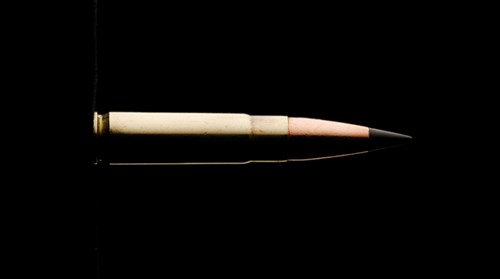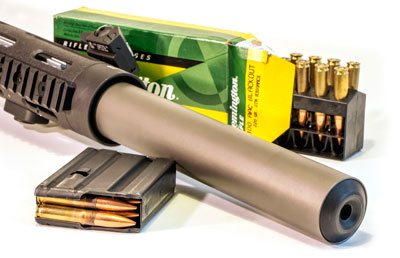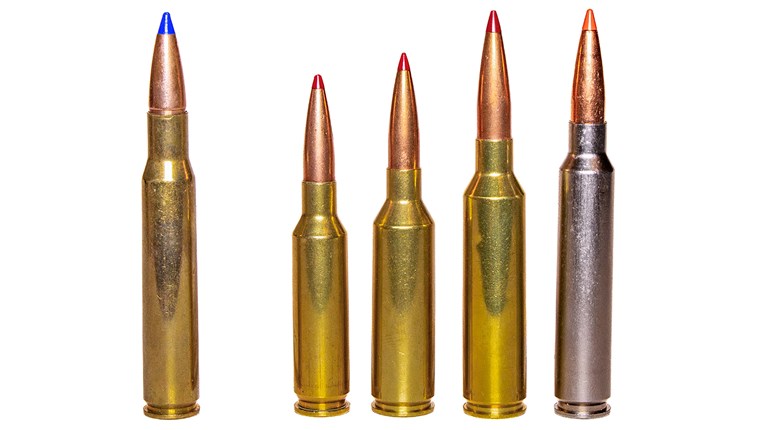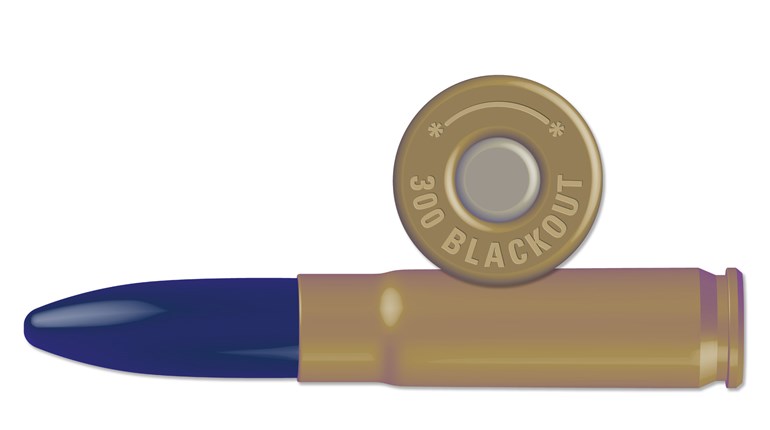

Few cartridges have created as much immediate and widespread buzz as the .300 AAC Blackout. We can speculate why, but I believe it has a great deal to do with the name. Marketing is an important part of selling anything, and "Blackout" just sounds cool. The question is, does the cartridge offer performance as cool as its name?
The .300 Blackout is a SAAMI-approved version of the wildcat cartridge known as the .300 Whisper, developed by J.D. Jones. Advanced Armament Corporation (AAC), working in conjunction with Remington, brought the .300 Blackout to market to offer a reliable and compact .30-caliber cartridge that would fit in a standard AR-15 magazine without diminishing capacity. The two companies also wanted a flash- and sound-suppressible cartridge that rivaled the ballistics of the 7.62x39 mm round with supersonic loads. And finally, they wanted it to function in a lightweight, durable rifle with minimal recoil.
With military service in mind, the platform was a given; the cartridge had to work in an M4-style carbine. The .300 Whisper was an obvious place to start because it was built on the .221 Rem. Fireball case, which has the same rim diameter as the .223 Rem./5.56 NATO. With a finalized case length of 1.368 inches, the .300 Blackout has a maximum overall cartridge length of 2.260 inches. It was approved by SAAMI in 2011 with a maximum average operating pressure of 55,000 psi, the same as the .223 Rem.
A variety of factory loads have emerged with bullets ranging in weight from 110 to 240 grains. Several of these loads use the same bullet but are loaded by different manufacturers. Still, a decent selection of ammunition has become available in less than two years, which speaks well to the cartridge's popularity.
But what exactly can you do with a .300 Blackout, and what can you expect from factory ammunition? To answer those questions I collected 11 loads, including supersonic and subsonic offerings, and two rifles. Given the current availability of ammunition and AR-platform rifles—which has only increased the popularity of the .300 Blackout even more—I think arranging a double-date for me and the ghost of John Wayne with Kate Upton and Carmen Electra would have been easier. I called in all my favors, rounded up at least two boxes of each load along with the rifles, and felt like I'd pulled a four-eared rabbit out of a hat.
I selected an AAC MPW carbine and a JP Enterprises PSC-11, each topped with a Leupold VX-3 4.5-14x40 mm riflescope, for testing. Both guns had 16-inch barrels, but the twist rate in the MPW barrel was 1:7 inches, while PSC-11's barrel was 1:8 inches. I used a Lehigh Defense Iroquois suppressor on the PSC-11 for each load, while the MPW went unsuppressed during testing.

For the first test, I fired a single, 10-shot group at 100 yards from a sandbag rest in less than 60 seconds. I recorded the velocity with a chronograph for each shot during this test. Why a 10-shot group? Primarily because ARs are repeatedly fired in a short amount of time, and I thought it would be interesting to see how well the rifles and ammunition performed during sustained fire. The process also provided a velocity record for every shot fired; the velocities listed in the chart represent the actual shots in the group.
The second test was firing each load into blocks of 10-percent ordnance gelatin from a distance of 20 feet. This established penetration potential, and provided an idea of what to expect with expansion and bullet-weight retention.
The performance of each load is highlighted in the accompanying tables, but based on nearly 350 rounds fired out of two rifles, I feel comfortable making some generalized assumptions. The first is supersonic .300 Blackout loads can be expected to shoot reasonably well in a rifle with a barrel having either a 1:7-inch or 1:8-inch twist rate. Ten-shot groups averaged 2.94 inches, and I've found five-shot groups normally average about 40-percent smaller. Accuracy with supersonic .300 Blackout loads is on par with most factory .223 Rem. loads. Supersonic loads reliably cycled in the rifles about 95 percent of the time.
In general, you can expect subsonic .300 Blackout loads to not be as accurate as supersonic offerings. The tests showed the overall group average of five subsonic loads in the two rifles was about an inch larger than the supersonic rounds. It's important to note none of the subsonic loads cycled either gun as configured 100 percent of the time. If you plan to run a .300 Blackout with both subsonic and supersonic ammunition, it would be wise to select a rifle with an adjustable gas block. Neither of the test rifles had this feature. Another option would be to tune your rifle for both types of ammunition if possible.
In my tests, the rifles cycled 50- to 60-percent of the time with subsonic loads. I believe you can expect similar ARs that do not have an adjustable gas block and that are tuned for supersonic ammunition to offer the same kind of reliability. Now to qualify this statement, magazines and suppressors can make a difference. To be consistent, I used only one magazine and one suppressor for all of the testing. Using the leftover ammo I experimented with a few other magazines, and while I saw some improvement, neither rifle exhibited 100-percent reliability with subsonic ammunition.

While the accuracy data obtained during these tests is gun specific, the terminal-performance results apply to any .300 Blackout rifle. With the exception of the Remington Premier Match 125-grain OTM load, which is not designed to expand, all the supersonic loads performed very well in the gelatin. Every subsonic round offered straight-line penetration, but only the Lehigh Defense Controlled Fracturing load showed any measurable damage inside the gel.
Based on previous tests with various .223 Rem. loads, the .300 Blackout in its supersonic form offers about the same terminal performance. Even though it can shoot heavier, .30-caliber bullets, they do not fly as fast. The diminished velocity sort of equalizes target damage. As a matter of fact, Barnes TSX bullets fired from a .223 Rem. will out-penetrate TTSX bullets fired from a .300 Blackout by 20 percent or more.
The .300 Blackout does have the subsonic advantage. There is a good selection of factory subsonic options, with the Lehigh Defense Controlled Fracturing load being a standout due to its ability to create measureable internal wounding. However, it appears from these tests you'll need to set up your rifle for subsonic work or opt for an AR with gas adjustment to get subsonic performance without sacrificing reliability.
Just like every other cartridge, the .300 AAC Blackout offers some specific advantages, but it is not perfect. This is a good thing, as it invites further development of both loads and rifles. It also leaves the door open for the next cool cartridge with a catchy name for us to experiment with in the future.
The 11 factory offerings that were covered are:
Hornady Custom 110-grain V-Max
Lehigh Defense 110-grain High Velocity Controlled Chaos
Barnes Vor-Tx 110-grain Barnes TAC-TX
DoubleTap Tactical 110-grain Barnes TAC-TX
Remington Premier 125-grain AccuTip BT
Remington Premier Match 125-grain OTM
Lehigh Defense 180-grain Controlled Fracturing
Hornady Custom 208-grain A-Max
Federal American Eagle 220-grain OTM
Remington 220-grain OTM
DoubleTap Tactical 240-grain Sierra MatchKing
Shooting Results:
| Supersonic Load | GUN | VEL | ACC | REL | PEN | EXP | RW |
| Hornady Custom 110-grain V-Max | JP PSC-11 | 2,380 | 3.12 | 100 | |||
| Hornady Custom 110-grain V-Max | AAC MPW | 2,348 | 2.55 | 100 | 13 | 0.60 | 52.3 |
| Lehigh Defense 110-grain High Velocity Controlled Chaos | JP PSC-11 | 2,328 | 1.70 | 100 | |||
| Lehigh Defense 110-grain High Velocity Controlled Chaos | AAC MPW | 2,334 | 3.70 | 80 | 36 | 0.31 | 47.0 |
| Barnes Vor-Tx 110-grain Barnes TAC-TX | JP PSC-11 | 2,380 | 2.69 | 70 | |||
| Barnes Vor-Tx 110-grain Barnes TAC-TX | AAC MPW | 2,388 | 2.94 | 90 | 20 | 0.61 | 110.0 |
| DoubleTap Tactical 110-grain Barnes TAC-TX | JP PSC-11 | 2,201 | 3.20 | 100 | |||
| DoubleTap Tactical 110-grain Barnes TAC-TX | AAC MPW | 2,176 | 4.66 | 100 | 18 | 0.60 | 110.0 |
| Remington Premier 125-grain AccuTip BT | JP PSC-11 | 2,305 | 2.50 | 100 | |||
| Remington Premier 125-grain AccuTip BT | AAC MPW | 2,333 | 2.41 | 90 | 19 | 0.55 | 105.5 |
| Remington Premier Match 125-grain OTM | JP PSC-11 | 2,193 | 3.33 | 100 | |||
| Remington Premier Match 125-grain OTM | AAC MPW | 2,223 | 2.55 | 100 | 12+ | 0.31 | 125 |
| Supersonic Averages | 2,299 | 2.94 | 95 | 19 | 0.49 | 91.63 | |
| Subsonic Load | |||||||
| Lehigh Defense 180-grain Controlled Fracturing | JP PSC-11 | 979 | 5.30 | 50 | |||
| Lehigh Defense 180-grain Controlled Fracturing | AAC MPW | 1,066 | 4.55 | 30 | 25 | .308 | 133.0 |
| Hornady Custom 208-grain A-Max | JP PSC-11 | 1,056 | 4.84 | 70 | |||
| Hornady Custom 208-grain A-Max | AAC MPW | 1,081 | 3.69 | 100 | 24+ | NR | NR |
| Federal American Eagle 220-grain OTM* | JP PSC-11 | 965 | 2.83 | 70 | |||
| Federal American Eagle 220-grain OTM* | AAC MPW | 1,033 | 3.70 | 50 | 24+ | NR | NR |
| Remington 220-grain OTM | JP PSC-11 | 1,076 | 3.40 | 80 | |||
| Remington 220-grain OTM | AAC MPW | 1,110 | 4.65 | 90 | 24+ | NR | NR |
| DoubleTap Tactical 240-grain Sierra MatchKing | JP PSC-11 | 956 | 3.41 | 30 | |||
| DoubleTap Tactical 240-grain Sierra MatchKing | AAC MPW | 1,046 | 2.70 | 0 | 24+ | NR | NR |
| Subsonic Averages | 931 | 3.90 | 57 | 24+ | NA | NA |
Velocity (VEL) measured in fps 15 feet from the muzzle for 10 consecutive shots using a Shooting Chrony chronograph. Temperature: 72 to 86 degrees Fahrenheit. Accuracy (ACC) measured in inches for one, 10-shot group at 100 yards fired from a sandbag rest. Reliability (REL) represents the percentage of time each rifle fully cycled. Bullet penetration (PEN) and expansion (EXP) measured in inches, obtained by firing each load into blocks of 10-percent ordnance gelatin positioned 20 feet from the muzzle. Recovered bullet weight (RW) measured in grains. NR = Not Recovered. NA = Not Applicable. * = engineering sample.






































